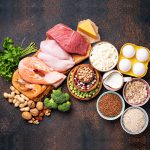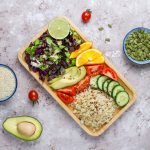We know how difficult and tiresome a weight loss journey can sound, but it need…
Read More
A lifestyle where we’re inundated with cheap junk food, and tend to spend long hours sitting sedately in front of a screen have made obesity an increasingly common problem today. And being overweight can have serious consequences for your health.
Your body mass index (BMI), which is a measure that takes your weight and height into account, is usually used to determine if you’re overweight. Typically, for adults a BMI:
However, if you’re very muscular you can have a high BMI without too much body fat. Therefore, waist size is often used as an additional measure to determine if you’re overweight. Typically, a waist size of 94cm or more in men and 80cm or more in women can mean that they’re likely to develop health problems related to obesity.[1][Obesity](https://www.nhs.uk/conditions/obesity/ “Obesity”).NHS,UK.
It is estimated that obesity can reduce your life expectancy by 3 to 10 years on average. And it can increase your chances of getting a range of conditions such as:
Ayurveda focuses on the expression of the five elements — air, space, fire, water, and earth — in the human body, spirit, and mind. These elements are thought to form three bioenergetic systems or doshas: pitta (fire and water), vata (air and space), and kapha (water and earth). Your body constitution or prakruti is determined by which dosha is predominant. Ayurveda also believes that an imbalance in these doshas leads to ill health.
In ayurveda, obesity is referred to as sthaulya (or medoroga). Sthaulya is considered to arise from an unhealthy diet, lack of exercise, genetic predisposition, and stress. These factors lead to an increase in kapha dosha which causes the excessive accumulation of fatty tissue. This is linked to the accumulation of earth and water elements in the body, and toxins in the digestive tract as well as poor digestive fire. Overeating, a sedentary lifestyle, excessive sleep and conditions such as anxiety and depression are thought to contribute to this condition.[3]Rioux, Jennifer, and Amy Howerter. “Outcomes from a whole-systems ayurvedic medicine and yoga therapy treatment for obesity pilot study.” The Journal of Alternative and Complementary … Continue reading
The simple formula for weight loss suggests that you need to expend more energy (calories) than you take in. A balanced low calorie diet and regular exercise can help you lose weight. Do keep in mind that you should not have a very low calorie diet (of around 800 calories or less per day) unless it has been recommended by and is being supervised by your doctor.[4][Very low calorie diets](https://www.nhs.uk/live-well/healthy-weight/very-low-calorie-diets/ “Very low calorie diets”).NHS,UK.
Some research indicates that a higher protein weight loss diet can result in greater loss of body weight and fat mass.[5]Leidy, Heather J., Peter M. Clifton, Arne Astrup, Thomas P. Wycherley, Margriet S. Westerterp-Plantenga, Natalie D. Luscombe-Marsh, Stephen C. Woods, and Richard D. Mattes. “The role of protein … Continue reading
Proteins are considered to be the building blocks of life. Every cell in your body contains protein. They are basically chains of amino acids. Proteins help your body make new cells as well as repair cells. They’re particularly key for growth and development in pregnant women, children, and teens.[6][Protein in diet](https://medlineplus.gov/ency/article/002467.htm “Protein in diet”). U.S. National Library of Medicine.
There are three kinds of amino acids:
The quantity of essential amino acids present in a protein is a measure of its nutritional value. Typically,
Animal products such as fish, beef, chicken, and dairy products, contain all the essential amino acids. They are, therefore, known as ‘complete’ proteins.
Quinoa, soy products, and amaranth seeds also contain all the essential amino acids.
Other plant proteins (such as lentils, beans, whole grains, and nuts) usually don’t contain at least one of the essential amino acids. Therefore, they’re considered ‘incomplete’ proteins.
What this means is that if you follow a vegan or vegetarian diet you need to get your protein from a variety of sources to ensure that all the essential amino acids are covered. For instance, a combination of legumes and cereals such as beans on toast will provide you all the essential amino acids.[8][Protein](https://www.betterhealth.vic.gov.au/health/healthyliving/protein “Protein”).Better Health Channel.
Your overall calories will determine the ideal amount of protein in your diet. It is recommended that healthy adults get 10 to 35% of their calories from proteins.[9][Protein in diet](https://medlineplus.gov/ency/article/002467.htm “Protein in diet”). U.S. National Library of Medicine. Each gram of protein and carbohydrate will give you 4 calories. While each gram of fat contributes 9 calories.[10][Fat and Calories](https://my.clevelandclinic.org/health/articles/4182-fat-and-calories “Fat and Calories”). Cleveland Clinic.
Ayurveda recommends having a balanced diet. It also advocates customizing your diet based on your prakruti or body constitution. For those with:
1. Vata constitution (who have a tendency to be lighter and less grounded): It is advisable to have more protein, though it’s considered to be ideally taken in small quantities during frequent meals. Sources of protein for this constitution include:
2. Pitta constitution (who tend to have more heat and stronger digestions): The following protein rich foods are considered suitable for them:
3. Kapha constitution (who have tendency towards heaviness): Ideally, plant proteins are thought to be best for this constitution. They can get their protein from
Proteins can support your weight loss efforts as it:
Research indicates that people feel fuller after having high protein meals. It has also been found that they have higher levels of hormones (satiety hormones) involved in signaling that you’re full.[11]Leidy, Heather J., Peter M. Clifton, Arne Astrup, Thomas P. Wycherley, Margriet S. Westerterp-Plantenga, Natalie D. Luscombe-Marsh, Stephen C. Woods, and Richard D. Mattes. “The role of protein … Continue reading
Metabolism is the process through which food is converted into energy by your body. But even when your body is at rest, it uses energy for functions such as circulating blood, breathing, repairing and growing cells, etc. The number of calories used by your body to perform these basic functions is called your basal metabolic rate.[12][Metabolism and weight loss: How you burn calories](https://www.mayoclinic.org/healthy-lifestyle/weight-loss/in-depth/metabolism/art-20046508 “Metabolism and weight loss: How you burn calories”). … Continue reading One study found that when people had a diet where 29% of the energy came from protein they had a higher resting metabolic rate than those who had a diet where 11% of the energy came from protein.[13]Pesta, Dominik H., and Varman T. Samuel. “A high-protein diet for reducing body fat: mechanisms and possible caveats.” Nutrition & metabolism 11, no. 1 (2014): 1-8. This means that a high protein diet can increase your energy expenditure.
It is best to stick within the limits of the recommended quantity for protein, ie, it should make up 10% to 35% of your calorie intake. Diets that are excessively high in protein:
References
| ↑1, ↑2 | [Obesity](https://www.nhs.uk/conditions/obesity/ “Obesity”).NHS,UK. |
|---|---|
| ↑3 | Rioux, Jennifer, and Amy Howerter. “Outcomes from a whole-systems ayurvedic medicine and yoga therapy treatment for obesity pilot study.” The Journal of Alternative and Complementary Medicine 25, no. S1 (2019): S124-S137. |
| ↑4 | [Very low calorie diets](https://www.nhs.uk/live-well/healthy-weight/very-low-calorie-diets/ “Very low calorie diets”).NHS,UK. |
| ↑5, ↑11 | Leidy, Heather J., Peter M. Clifton, Arne Astrup, Thomas P. Wycherley, Margriet S. Westerterp-Plantenga, Natalie D. Luscombe-Marsh, Stephen C. Woods, and Richard D. Mattes. “The role of protein in weight loss and maintenance.” The American journal of clinical nutrition 101, no. 6 (2015): 1320S-1329S. |
| ↑6, ↑9 | [Protein in diet](https://medlineplus.gov/ency/article/002467.htm “Protein in diet”). U.S. National Library of Medicine. |
| ↑7 | [Amino acids](https://medlineplus.gov/ency/article/002222.htm “Amino acids”). U.S. National Library of Medicine. |
| ↑8, ↑14 | [Protein](https://www.betterhealth.vic.gov.au/health/healthyliving/protein “Protein”).Better Health Channel. |
| ↑10 | [Fat and Calories](https://my.clevelandclinic.org/health/articles/4182-fat-and-calories “Fat and Calories”). Cleveland Clinic. |
| ↑12 | [Metabolism and weight loss: How you burn calories](https://www.mayoclinic.org/healthy-lifestyle/weight-loss/in-depth/metabolism/art-20046508 “Metabolism and weight loss: How you burn calories”). Mayo Clinic. |
| ↑13, ↑15 | Pesta, Dominik H., and Varman T. Samuel. “A high-protein diet for reducing body fat: mechanisms and possible caveats.” Nutrition & metabolism 11, no. 1 (2014): 1-8. |


With 6+ years of experience as a medical nutritionist, Ninny Sunny has worked with hospitals and brands like HealthifyMe and CureFit to guide people on lifestyle and nutritional issues. She is an expert in evaluating the nutritional status of people and can advise a balanced nutritional plan for optimizing overall health and wellness.

We know how difficult and tiresome a weight loss journey can sound, but it need…
Read More
The key to healthy weight loss is achieving a negative energy balance or taking in…
Read More
Thanks for choosing Kapiva! Ayurveda is about balance, the same translates to its view on…
Read More
Welcome! We are truly thrilled to have you on board with us on Kapiva's personalised…
Read More